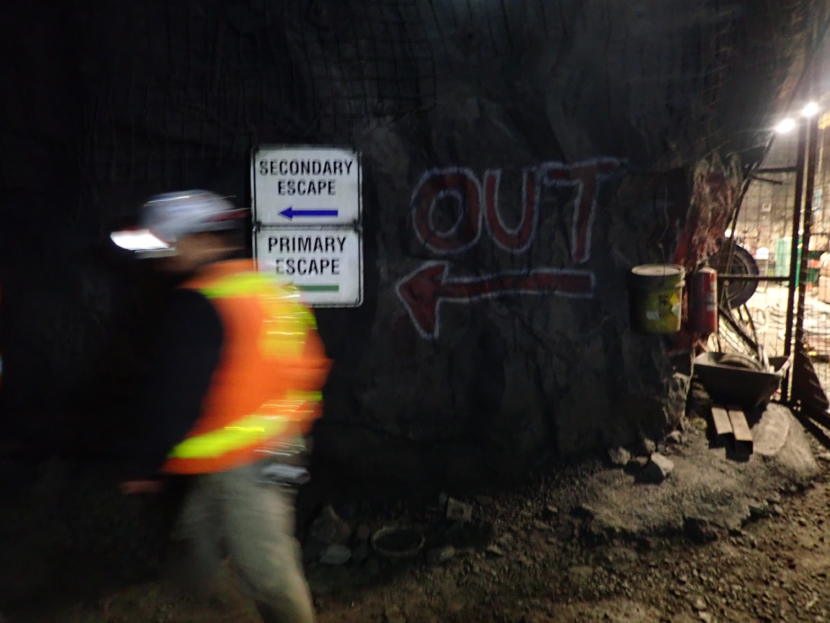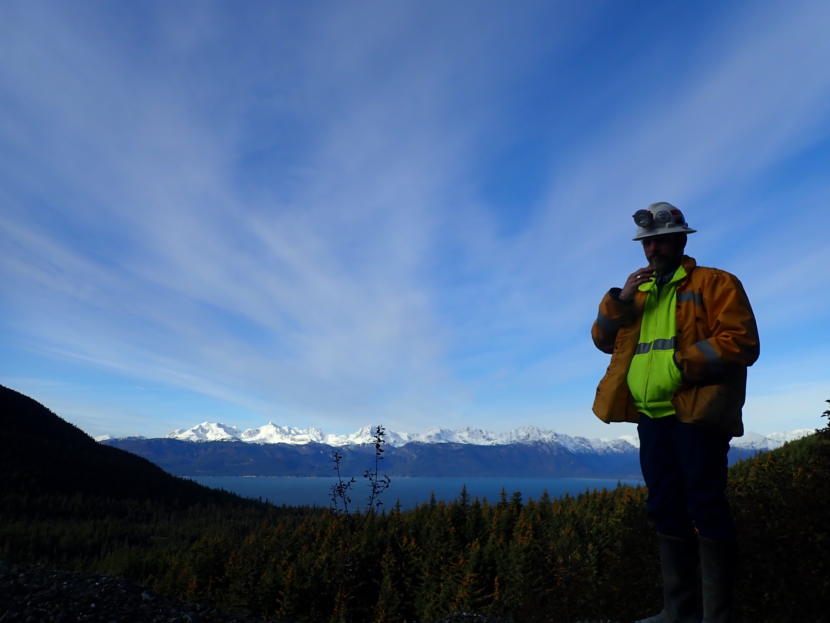
Growth at the Kensington Gold Mine means the mine will need to expand its footprint considerably to keep operating for another decade.
The modern Kensington Gold Mine began operations in 2010. But its 28 miles of underground tunnels follow veins first explored and blasted more than a century ago.
Today, there are a number of sections underground that carry the names of 19th century and early 20th century operations in a remote area about 45 miles north of downtown Juneau.
“Kensington came from the historic Kensington mine, the Jualin came from the Jualin Mine,” Coeur Alaska’s General Manager Mark Kiessling told CoastAlaska during a recent site tour.
There’s heavy machinery loading ore to be milled into gold concentrate in the Elmira section. That follows the historic Elmira Mine though Coeur Alaska is only now expanding its blasting and drilling here.

The point of showing all this is to demonstrate that 10 years into operations, there’s a lot of ore left to mine. But the mine company faces a challenge: it’s running out of room for the waste rock and tailings it’s generating as it mines ore and mills it into gold concentrate.
“We know that there’s additional veins out there,” Kiessling said.
The company projects it’ll be out of room for waste rock in 2022. And its tailings facility will be at capacity by 2024. Coeur Alaska — a subsidiary of Chicago-based Coeur Mining — has already started the permitting process to expand.
Filings with the U.S. Forest Service envision expanding three existing waste rock storage piles, adding a new one and to expand its footprint by 150 acres of the mine that’s on a patchwork of public and private land.
More controversially, the plan calls for expanding its tailings treatment facility. That’s a body of water that once appeared on maps as Lower Slate Lake.

A U.S. Supreme Court decision in 2009 struck down environmentalists’ legal challenges. And for the first time in the United States, a mine operator was permitted to convert a natural lake into a holding pond for liquid mine waste.
To expand, the mine company wants to raise the lake’s artificial dam by 36 feet and buffer the opposite shoreline with rock.
“It would enable us to contain another 4 million tons of tailings,” Kevin Eppers, the mine’s environmental manager, told CoastAlaska.
And the company proposes a rock causeway to reinforce the lake’s shoreline to prevent the water line from spilling into the adjacent Upper Slate Lake.
Upper Slate Lake is a second natural lake that so far has been untouched by mine waste. Eventually, the company plans to flood Lower Slate Lake so that the two merge into one after the mine closes down for good.
Kiessling said the two lakes would merge only after the lower lake containing submerged mine waste is brought up to state water standards. That would be accomplished by filtering the water at its wastewater treatment plant.
“We would continue to treat until we reach those levels and if we weren’t able to reach those levels we continue to treat and treat and treat,” Kiessling said.

After which the mining company would allow the water to rise in the lower lake, spilling over the man-made causeway and leaving behind a single body of water capable of supporting fish habitat, including Dolly Varden.
“It’s going to be restored as a high quality lake,” he said.
So far a half dozen people have written to the U.S. Forest Service about the expansion. Two are in support, noting that Kensington Mine is one of the Southeast Alaska’s largest employers with nearly 400 people on its payroll.
Four letters were critical of the mine’s expansion. One in particular noted how in August the Environmental Protection Agency fined the mining company more than a half million dollars for permit violations.
Kensington’s proposed expansion has reigniting debate over the long-term safety of the mine on Lynn Canal and the surrounding watershed.
“Berners Bay is a natural resource that for all intents and purposes has existed forever,” staff scientist Guy Archibald of the Southeast Alaska Conservation Council said in a recent interview.
SEACC unsuccessfully sued to prevent Kensington from opening in the mid-2000s.
“We hope that it will continue to exist forever and not be completely destroyed by a mine that lasted 20 to 30 years,” Archibald said.
One of the EPA violations was for acidic runoff along the tailings dam. Mine engineers have been spraying concrete to try and contain the runoff with mixed results. The EPA has since modified the mine’s permit to allow acid rock runoff into the lake. But only after levying fines this summer.
Kiessling defends the mine’s environmental record and predicts raising the water levels in the tailings pond would address the acid runoff problem.
“By building the higher dam,” he said, “we feel that that’s going to give us an opportunity to kind of put that issue issue to rest.”
Kensington’s proposed expansion will go under a formal environmental review. But first the public has until Nov. 7 to weigh in on how much or how little the mine should be allowed to expand its footprint in the Tongass National Forest.